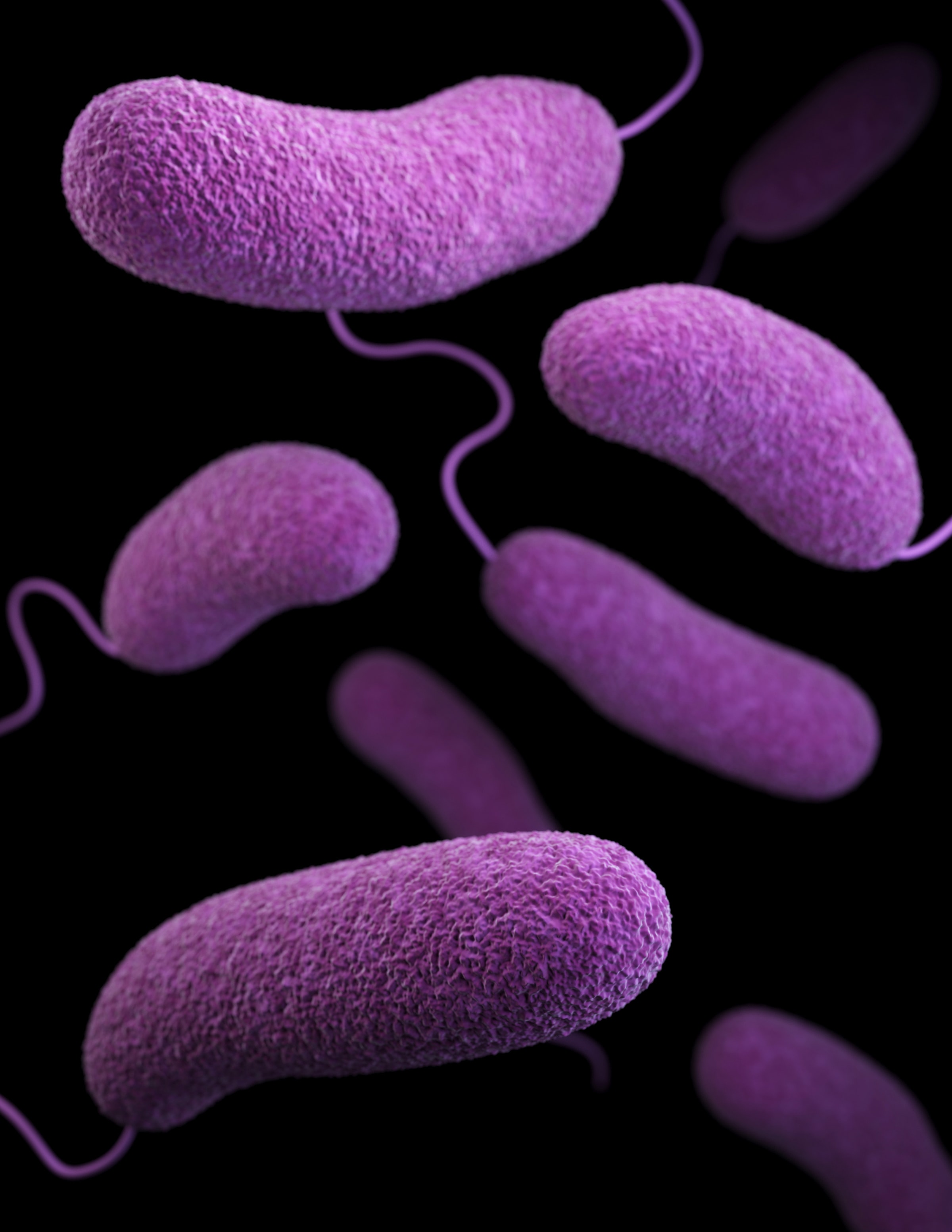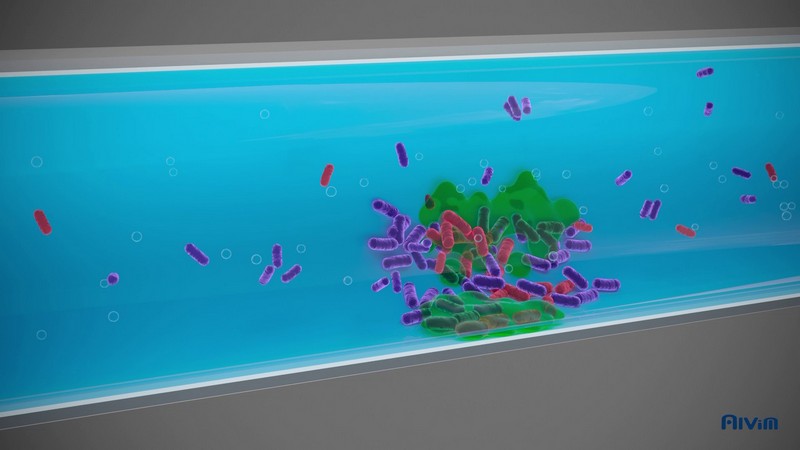Legionella prevention [Download this white paper as PDF file]
Legionella is a type of Gram-negative aerobic bacteria, a flagellated rod 0.5 µm wide and 2 µm long. Its name is due to the epidemic that spread in the summer of 1976, during a gathering of veterans of the American Legion, in Philadelphia. L. pneumophila, originally isolated during this outbreak, is still responsible for most of the infections. It is the causative agent of a potentially fatal form of pneumonia, named Legionnaires' disease.
In the environment, this ubiquitous bacterium is normally found in fresh water as an intracellular pathogen of amoebae, and in biofilms. Humans become infected with L. pneumophila by inhaling aerosols from these contaminated water sources. Then bacteria replicate inside alveolar macrophages, causing a severe form of pneumonia.
Habitat
L. pneumophila is commonly found in spring waters - including thermal waters - rivers, lakes and sludge, surviving both planktonically and as an intracellular parasite of protozoa. Recent studies suggest that this bacterium is part of the natural aquatic environment and it is capable of surviving extreme ranges of environmental conditions. The layer of bacteria that covers any surface in contact with liquids, commonly known as biofilm, is a widespread ecological niche in which Legionella proliferates. Elevated temperature, inorganic and organic content of the water and the presence of host protozoa play a key role in the growth and spread of this bacterium. The optimal temperature for Legionella survival and growth is 30-40 °C.
From natural environments, Legionella easily reaches the artificial ones, like building water systems, water tanks, pipes, fountains, pools, that can act as incubators for this microorganism, creating a potentially hazard condition for human health. Especially the warm water systems provide an ideal habitat for massive growth of the bacterium. In addition, the presence of dead-legs and stagnation in plumbing systems are potential risk factors. Also pipe material has been shown to influence the occurrence of high bacterial concentration. The use of copper as plumbing material may help to minimize the risk of Legionnaires' disease, whereas plastic materials can support a high number of L. pneumophila.

Hazard to human health
Human infection occurs exclusively by inhalation of contaminated aerosols, that can be produced by air conditioning systems, cooling towers, whirlpools, spas, fountains, and shower heads, among the others. Several studies demonstrated a seasonality of infection, with the highest frequency of infection occurring during summer.
The diseases caused by Legionella are collectively termed legionellosis. Legionnaires' disease is the pneumonic form of legionellosis with an incubation time of 2-10 days, while the benign flu-like form is called Pontiac fever. Mortality rate of adequately treated Legionnaires' disease varies from 7% to 24%, with elderly and immuno-compromised patients being most susceptible. The disease begins with a mild cough, malaise, muscle aches, low fever and gastrointestinal symptoms. The later manifestations of disease are high fever, alveolitis and bronchiolitis. Due to a higher percentage of elderly and immunocompromised people in the society, the number of people who are particularly susceptible to Legionella infection has increased, over the last few decades.
Legionella and biofilm
While L. pneumophila replicates within protozoa, its colonization and persistence in the environment are also mediated by biofilm formation. There is now evidence that some legionellosis outbreaks are correlated with the presence of biofilms. Thus, preventing biofilm formation appears as a key strategy to reduce the possible contamination of water systems.

Recent reports suggest that the growth of Legionella in biofilms may lead to enhanced virulence. Moreover, preliminary data indicate that biofilm-derived L. pneumophila evades the innate immune response in macrophages. As legionellosis is not trasmitted from person to person, insights into the ecology of L. pneumophila may yield information that can be used to prevent the colonization of anthropogenic systems. In absence of available abiotic surfaces, L. pneumophila may even attach to protozoa in floating biofilms. The intracellular stage of L. pneumophila provides protection from environmental stressors, including heat treatment and biocides used to disinfect water systems.
Because of these threats, and of the resilience of Legionella found in biofilms, there is a great interest in improving methods for eradicating biofilms that may contain this pathogen. Since it is virtually impossible to know if in a water system there is a biofilm hosting L. pneumophila, the only safe approach is to eliminate any biofilm as soon as it starts to form.
Prevention of Legionellosis
Since person-to-person transmission has never been observed, the prevention of Legionella infections is focused on the elimination of the pathogen from water supplies. In US and EU, in high-risk areas such as intensive care units, regular monitoring of Legionella concentrations is mandatory. The World Health Organization (WHO) develops, updates and disseminates guidance documents and best practices, norms and standards that support regulations at national level, in particular for drinking-water safety, effective surveillance approaches, recreational water quality, sanitation safety and safe wastewater use. Several Countries have issued regulations about the maximum limit of "microbiological pollutants" - including Legionella - in water intended for human consumption. Aiming at protecting human health from adverse effects of contaminated water consumption, the European Directive 2184/2020 indicates the maximum concentration of microorganisms, pathogens - also in this case including Legionella - and other substances potentially dangerous for human health.
Currently, rapid test kits for Legionella represent the fastest and most convenient way for the detection of this pathogen, both in water and in biofilms. High levels of Legionella entail the need for an appropriate decontamination, followed by periodic maintenance of water systems, to prevent further outbreaks.
In the recent years, a number of methods for controlling the growth of Legionella in drinking water supply systems and in cooling towers have been described, including heat flushing, ultraviolet light irradiation, ozonation, metal ionization and biocides.
Unluckily, the decreased heat transfer and biocide penetration into biofilms, as well as unused pipes in water systems, often limit the efficacy of disinfection. The interaction with amoebae offers an additional shelter to Legionella, and this is complicated by the fact that protozoa may become resistant to biocides.
Conclusions
Over the last 50 years, it has been demonstrated that Legionella is widely present both in natural environment and in artificial structures. Representing a potential threat to human health, it is essential to prevent its spread. Biofilm is the ideal environment for survival and growth of this pathogen, thus its monitoring and eradication play a key role in Legionella prevention. This is valid in particular for water intended for human consumption, and where the public can get in contact with the aerosol produced by water.
Detecting biofilm since its very first phase, the ALVIM Technology allows to apply sanitation treatments when bacteria are easier to eliminate, preventing in this way the proliferation of harmful pathogens.
|
Do you have biofilm-related issues?
|





